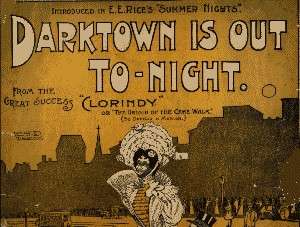Clorindy: The Origin of the Cakewalk
Clorindy, or The Origin of the Cake Walk[1] is a one-act musical by composer Will Marion Cook and librettist Paul Laurence Dunbar.

The piece premiered in 1898 and was the first Broadway musical with an all-black cast. It starred the famous African-American performer Ernest Hogan. Popular songs from the show included "Who Dat Say Chicken In Dis Crowd" (one of the first documented uses of the well-known "Who Dat?" comedy motif)[2] and the finale, "Darktown Is Out Tonight".[3]
Development
Despite his traditional musical education in music schools in Europe and America, Cook believed that "Negroes should eschew white patterns" and work to create unique styles to reflect their unique culture, rather than imitating the music of whites. Cook dreamed of presenting the first musical play with an all black cast on Broadway.[4] Encouraged by the vaudeville duo Bert Williams and George Walker, Cook recruited his friend, poet Paul Laurence Dunbar, to write the book and lyrics for the new show.[4] The duo completed the music and lyrics for the production in a single night in a basement near Howard University "equipped with beer, whiskey, a T-bone steak, but no piano." [4] Dunbar found the collaboration so unpleasant that he vowed never to work with Cook again, but the two nonetheless collaborated on several more productions, including 1903's In Dahomey.[5]
Songs
Productions
Cook sought a producer and venue in New York. He met much rejection before bringing his cast uninvited to a rehearsal hall where he heard that another act was auditioning for Edward E. Rice, manager of the Casino Theatre's Roof Garden. Rice eventually agreed to present it.[4] The musical was adapted for the venue, with Rice removing most of Dunbar's dialogue, as the rooftop setting made spoken dialogue difficult to understand over the noise from the street. Clorindy was first presented on July 4, 1898 as an afterpiece to Rice's production Summer Nights, and it was a hit,[3] prompting Cook to boast that "My chorus sang like Russians, dancing meanwhile like Negroes, and cakewalking like angels, black angels!"[7] He declared that "Negroes are at last on Broadway, and here to stay!"[4]
Clorindy had a brief run, also starring Hogan, at the Boston Music Hall in mid-January, 1901.[8]
Cook would later write the first Broadway musical with an integrated cast, The Southerners, in 1904.[4]
References
- The original title was The Origin of the Cake Walk. By the end of the first run, it had evolved into Clorindy, or the Origin of the Cake Walk. See, for example, New York Herald, July 31, 1898, and Edward E. Rice's advertisement in the August 20, 1898 New York Dramatic Mirror.
- Hollis Robbins, "The Origin of 'Who Dat?' It goes back to minstrelsy, but it’s OK to say it now" Archived 2011-08-18 at the Wayback Machine, The Root, February 9, 2010.
- Bernard L. Peterson, A Century of Musicals in Black and White: An Encyclopedia of Musical Stage Works By, About, or Involving African Americans (Greenwood Publishing Group, 1993), ISBN 978-0313266577, pp. 84-85.
- Woll, Allen (1989). Black Musical Theatre: From Coontown to Dreamgirls. Baton Rouge: Louisiana State University Press.
- Jones, John Bush (2004). Our Musicals, Ourselves: A Social History of the American Musical Theatre. Waltham, MA: Brandeis.
- Based on collective titles on cover of Will Marion Cook, Gems From Clorindy: A Negro Musical Farce, New York: M. Witmark & Sons, 1898.
- Brooke Baldwin (1981). "The Cakewalk: A Study in Stereotype and Reality". Journal of Social History. 15 (2): 205–18. doi:10.1353/jsh/15.2.205.
- Music Hall ad, Boston Daily Globe, January 16, 1901.
External links
| Wikimedia Commons has media related to Clorindy. |
- Libretto for "Who Dat Say Chicken In Dis Crowd" from Clorindy at Wright State University Libraries
- Clorindy: The Origins of the Cake Walk: Scores at the International Music Score Library Project (IMSLP)
- "A Day in the Life" podcast on the history and music of Clorindy